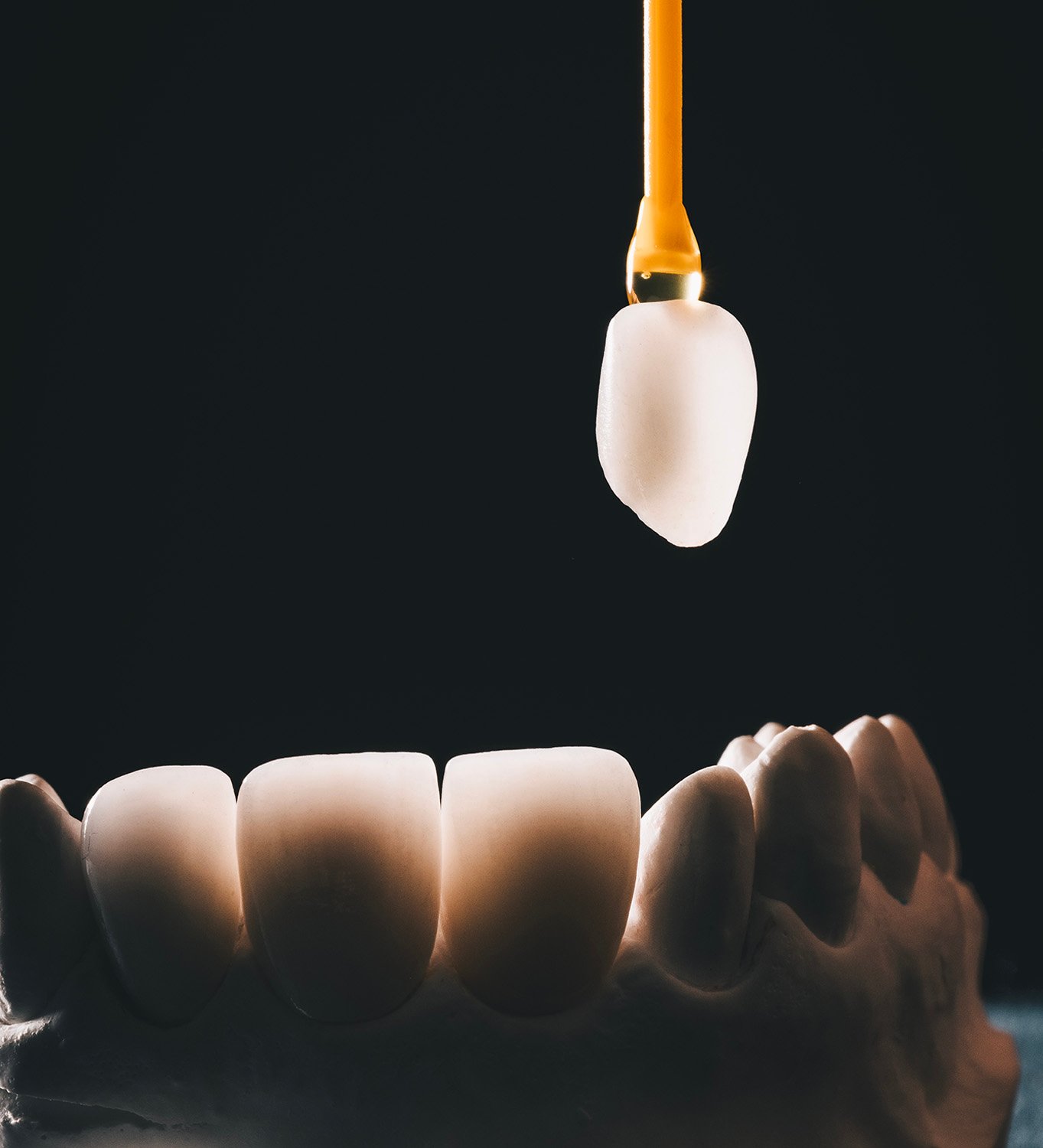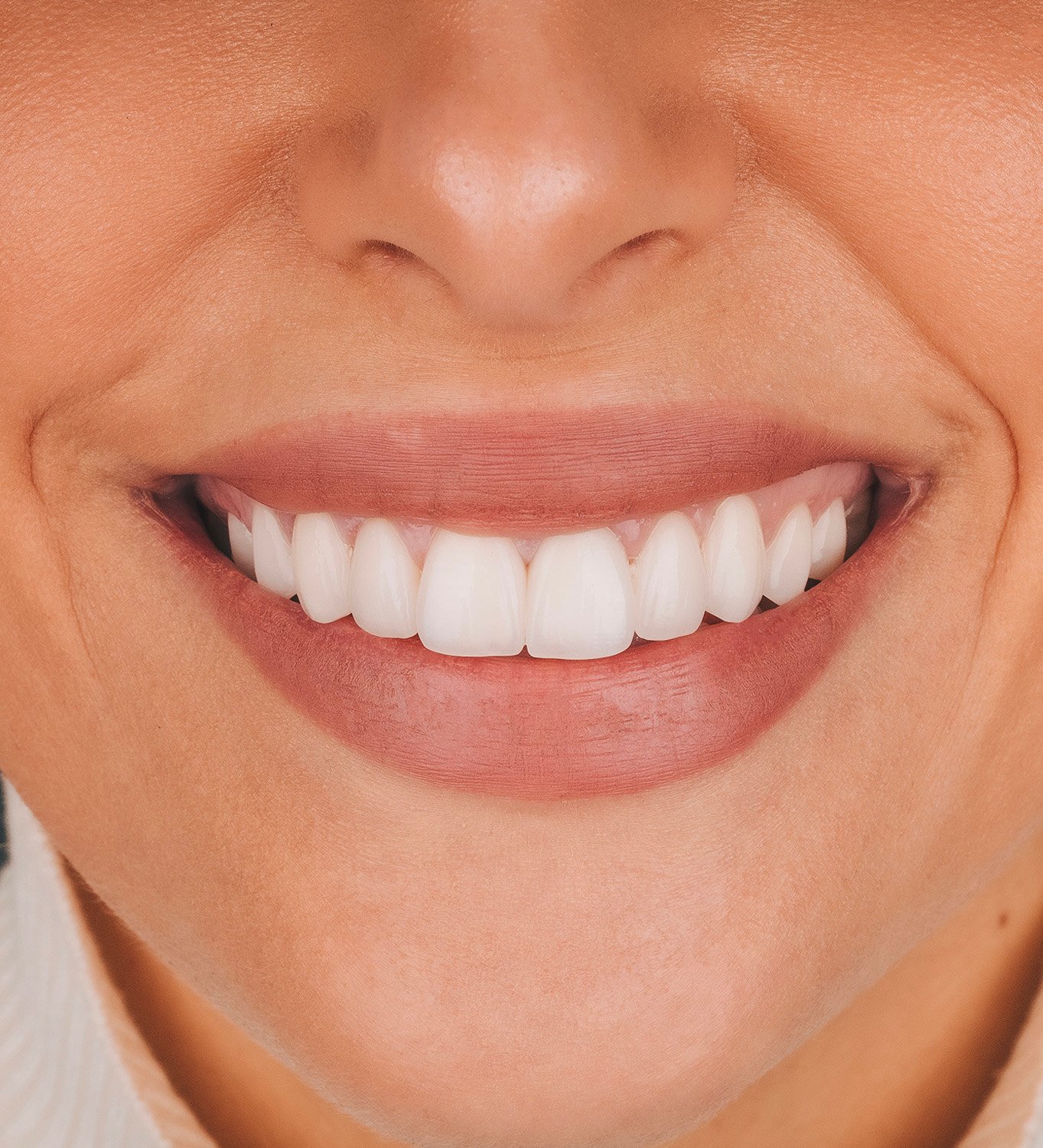Dental Veneers
What are veneers for?
Placing dental veneers is one of the most sought-after treatments in aesthetic dentistry. This is due to its versatility in solving functional problems and improving the smile’s aesthetics.
Dental veneers work as very thin covers, just a few millimetres long – which is why they are also known as dental contact lenses – attached to the outer surface of the teeth to be treated. In this way, they can correct tone, shape, slight misalignments, or diastemas with very natural results.
They can be ceramic or composite resin. In addition to being stronger, ceramic veneers have excellent biocompatibility (the body tolerates them well) and excellent long-term chemical stability. They also have the advantage of a minimally invasive approach, which allows the correction of the tooth structure’s buccal (front) side.


A custom-designed smile
The placement of dental veneers allows a high degree of customization of Oral Rehabilitation, taking into account the smile’s functionality and aesthetics. Each veneer is designed exclusively for each patient and according to his or her expectations, always striving for a perfect fit.
Given their characteristics, they can mimic the natural enamel on your teeth, creating a completely natural smile. Today’s materials (ceramic or composite resin) allow the dental veneers to be thinner and thinner, becoming unnoticeable and imitating almost perfectly the patients’ natural dentition.
A minimally invasive procedure
Due to the evolution of the technique and the materials used, it is not always necessary to wear the teeth for the application of dental veneers. The indication for wear varies according to the positioning of the teeth and the existence or not of space to place the dental veneers.
In case the space is insufficient, orthodontic treatment may be recommended. The idea is to align the teeth and place them in the ideal position for placing the dental veneers without needing wear.
However, even in cases where it is necessary to wear down the teeth, this is minimal and only in the superficial enamel area without compromising the tooth structure.

Step by step of placing dental veneers
To place dental veneers, a whole process must be followed to obtain the best final result.
- Evaluation/Diagnosis Consultation
Through clinical evaluation and auxiliary exams, such as radiographs (orthopantomography and CT), photographic protocol, and intraoral digital scan, a diagnosis is made. The treatment is defined according to the functional and esthetic parameters and the patient’s expectations.
The duration of treatment is variable and depends on the complexity of the case and the techniques implemented.
- DSD — Digital Smile Design
DSD is a digital simulation tool that makes it possible to perform Oral Rehabilitation planning. From this digital study, and taking into account the data gathered in the initial evaluation, a 3D mock-up of the patient’s future smile is made.
- Mock-up (smile test drive)
With this simulation of the final treatment result, it is possible to do a test in the patient’s mouth without involving any dental intervention. Thus, the patient can see and approve their smile design early and ensure their expectations are met.
New photographs are taken, and the patient’s lip dynamics, phonetics, and comfort are tested.
- Intermediate consultations
Oral hygiene consultation is essential before any treatment to ensure stable gum health. This phase may also include treatments for:
- Orthodontics, for tooth alignment and tooth movement to the ideal position for the placement of dental veneers and crowns;
- Dentistry, such as removing dental caries lesions or restoring weakened structures;
- Oral Implantology and Endodontics.
Before placing dental veneers, it is advisable to apply dental bleaching so that the teeth’ colour is more uniform.
- Dental preparation
Although minimally invasive, it may be necessary to slightly grind the outer surface of the teeth so that the adaptation is the best and the final result is as harmonious as possible. We then proceed with the digital and conventional impression for the execution of the dental veneers.
The temporary work is placed, and as the teeth are united, some care must be taken when eating, such as avoiding very hard, crunchy, and pigmented foods.
- Adhesion/cementation of dental veneers and crowns
Local anaesthesia is administered, followed by removing the provisional material and adhesion of the final work. According to a strict protocol, all steps of this consultation are performed with extreme attention to the smallest details.
Post-cementing recommendations
Often, the success of dental treatments also depends on the patient’s behaviour. Therefore, here are some recommendations to be followed after the cementation of dental veneers:
- Application of gel and mouthwashes with mouthwash (a kind of elixir, but without alcohol) for five days to recover gum health;
- Dental veneers function like normal teeth. As such, they can break if there are excesses, such as nail biting, biting pens and other objects, bruxism;
- Avoid biting with front teeth, tough foods;
- Use a night guard, especially in cases of bruxism.
The frequency and nature of routine consultations are defined according to the treatment performed.

Prof. António Duarte Mata
Dentist

Dr Carlota Duarte de Mendonça
Medical Doctor Dentist

Dr Cristina Palma
Medical Doctor Dentist

Dr Diana Bernardo de Macedo
Medical Doctor Dentist

Dr. Diogo Nuno
Dentist

Dr Filipa Teixeira Gomes
Medical Doctor Dentist

Dr. Hugo Madeira
Dentist

Dr Inês Martins Pereira
Medical Doctor Dentist

Dr Marta Costa Quinta
Medical Doctor Dentist

Dr Rita Bernardes Nascimento
Medical Doctor Dentist

Dr Teresa de Lima Mayer
Medical Doctor Dentist
